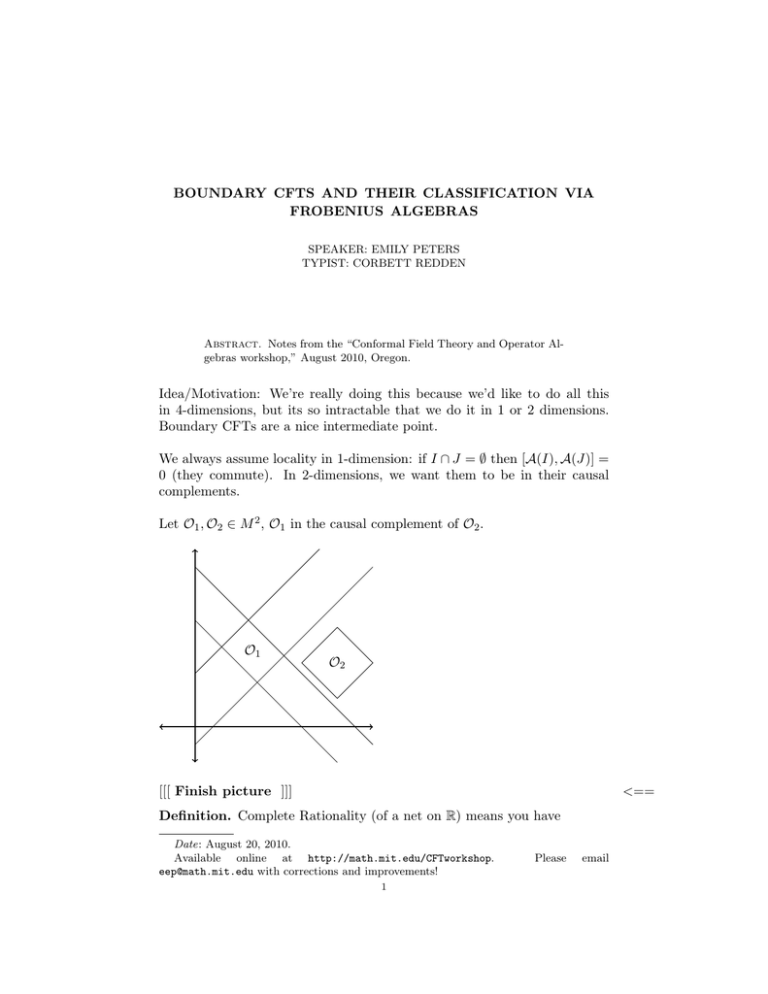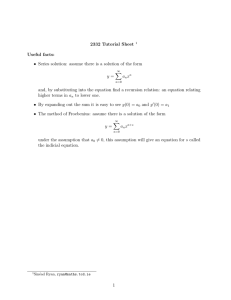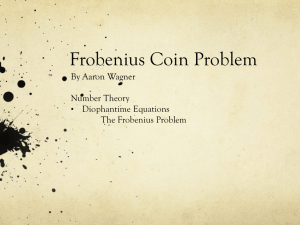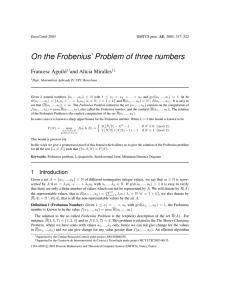BOUNDARY CFTS AND THEIR CLASSIFICATION VIA FROBENIUS ALGEBRAS
advertisement

BOUNDARY CFTS AND THEIR CLASSIFICATION VIA
FROBENIUS ALGEBRAS
SPEAKER: EMILY PETERS
TYPIST: CORBETT REDDEN
Abstract. Notes from the “Conformal Field Theory and Operator Algebras workshop,” August 2010, Oregon.
Idea/Motivation: We’re really doing this because we’d like to do all this
in 4-dimensions, but its so intractable that we do it in 1 or 2 dimensions.
Boundary CFTs are a nice intermediate point.
We always assume locality in 1-dimension: if I ∩ J = ∅ then [A(I), A(J)] =
0 (they commute). In 2-dimensions, we want them to be in their causal
complements.
Let O1 , O2 ∈ M 2 , O1 in the causal complement of O2 .
O1
O2
[[[ Finish picture ]]]
<==
Definition. Complete Rationality (of a net on R) means you have
Date: August 20, 2010.
Available online at http://math.mit.edu/CFTworkshop.
eep@math.mit.edu with corrections and improvements!
1
Please
email
2
SPEAKER: EMILY PETERS TYPIST: CORBETT REDDEN
(1) Split property: I ∩ J = ∅ ⇒ A(I) ∨ A(J) = A(I) ⊗ A(J)
(2) Strong additivity: A((a, b)) ∨ A((b, c)) = A((a, c))
(3) Finite index: µ2 < ∞
Let M+ = positive Minkowski space = {(t, x) | x > 0}. Consider double
cones O
J
L
K
O
I
.
0.1. Boundary CFTs.
Definition. A boundary CFT over a given 1-d conformal net A is an assignment O 7→ B+ (O) ⊂ B(H) satisfying locality, isotony, equivariance with
respect to an action of P SL2 (R) on M+ and H, and
• existence and uniqueness of a vacuum vector Ω ∈ B(H),
• covariance: U (g)B+ (O)U (g)∗ = B+ (gO) when gO is a double cone,
• an action π of the net A on H, covariant under P SL2 (R); i.e.
U (g)π(A(I))U (g ∗ ) = A(gI),
• Joint irreduciblity: Where π(A)00 = the vNA generated by all of
π(A(I)), then
π(A)00 ∨ B(O) = B(H).
Example. Trivial BCFT over A is
O 7→ A+ (O) := A(I) ∨ A(J)
Dual to trivial
0
O 7→ Adual
+ (O) := A(K) ∩ A(L).
BOUNDARY CFTS AND THEIR CLASSIFICATION VIA FROBENIUS ALGEBRAS
3
0.2. Relations between different mathematical objects. Fix a particular 1d CN A(I) and examine BCFT over A. Focus on Haag dual BCFTs
over A. These are in 1-1 correspondence with chiral extensions of A, i.e. 1d
CN which extend A. These in turn are classified by superfactors of A (of
index µ2 ). These are in bijection with Frobenius algebras (in some category
coming from A).
BCFT over A
Q-systems
(·)gen
Haag dual BCFT
over A
superfactors
of A of
index µ2
Chiral extensions of A
(·)ind
Frobenius algebras in
(a suitable category
coming from) A
conditional expectation and basic construction
The construction going from a Haag-dual BCFT over A to a chiral extension
is gen, and going the other way is incl.
Definition. By locality B+ (O) ⊂ B+ (O0 )0 . The BCFT B is Haag dual if
this inclusion is an equality.
Definition. Given a BCFT B+ over A, its boundary net B gen is given by
B gen (I) := B+ (WI ),
where WI is the finite wedge determined by I, and B+ (WI ) is the algebra
generated by B+ (O) for all O ⊂ WI . This is possibly non-local, though
relatively local with respect to A; i.e.
[A(I), B(J)] = 0.
Theorem 0.1 (or definition). Given an irreducible (non-local) chiral extension B of A, the induced BCFT
ind
B+
(O) := B(L) ∩ B(K)0 .
Then, we check that
ind )gen = B
• (B+
dual
• (B gen )ind
+ =B
Facts:
• Given chiral extensions I 7→ B(I) ⊃ A(I), we have a consistent
family of conditional expectations
εI : B(I) → A(I)
4
SPEAKER: EMILY PETERS TYPIST: CORBETT REDDEN
such that I ⊂ J ⇒ εI |J = εJ .
• If irreducible and finite index, then εI is implemented by ε : B → A.
Theorem 0.2 (Reeh–Schlieder). The vaccum vector Ω is cyclic and separating for any B(I).
Theorem 0.3. Classifying chiral extensions B of A is equivalent to classifying “extensions” of A(I).
0.3. Superfactors to Frobenius algebras. What is the “some category
coming from A?” Objects are elements in End(A), and morphisms are intertwiners a ∈ A such that for a ∈ (ρ, σ), then aρ(x) = σ(x)a.
Frobenius algebra in a category C consists of an object Q, multiplication
m : Q ⊗ Q → Q, η : 1 → Q such that (Q, m, η) is a monoid. ∆ : Q →
Q ⊗ Q, : Q → 1 such that (Q, ∆, ) is a co-monoid. And, with I = H
relation: (m ⊗ 1) ◦ (1 ⊗ ∆) = ∆ ◦ m.
Example. G finite group with group ring C[G] = C{g ∈ G}. Then
m(g, h) = gh
X
(
ag g) = ae
X
∆(g) =
a⊗b
ab=g
η(1) = 1
Example. Subfactors and the canonical endomorphism. Let N ⊂ M be
type III1 subfactors, JN , JM the modular conjugations of N, M (with respect
BOUNDARY CFTS AND THEIR CLASSIFICATION VIA FROBENIUS ALGEBRAS
5
to a cyclic and separating vacuum vector Ω ∈ H).
γ : M −→ N
∗
x 7−→ JN JM xJM
JN
Given N ⊂ M , we define a Frobenius algebra in End(M ). Let γ be the
canonical endomorphism γ = ιι, where ι : N ,→ M , ι : M → N.1
Given a Frobenius algebra in End(M ), it gives a subfactor E : M → N by
defining E(x) = mρ(x)∆.
Proof: This is a bimodule map whose image is an algebra! Want to show
E(xE(y)) = E(x)E(y)
End proof.
1ι = ι−1 ◦ γ, where γ is from the example above.




